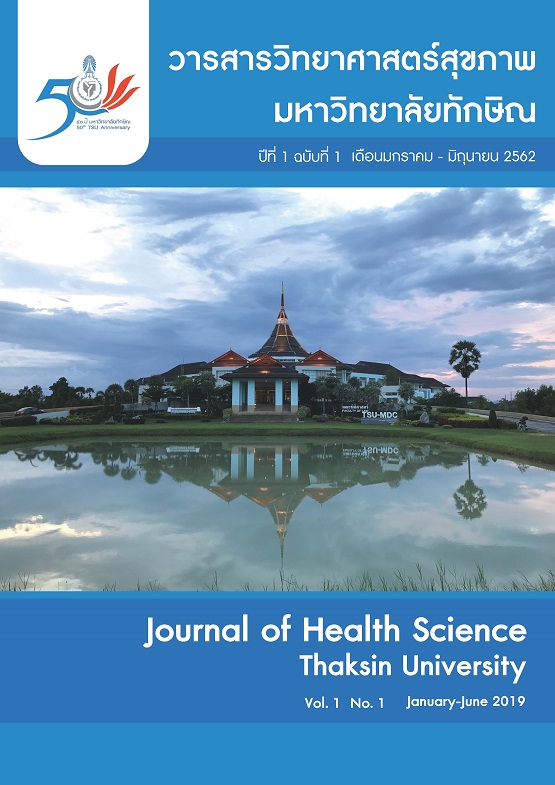Effects of Perceived Health Promotion Program towards Health Care Behavior and Serum Lipid Level among Individuals with Dyslipidemia
Main Article Content
Abstract
The purpose of this quasi-experimental research was to investigate the effects of perceived health promotion program towards health care behavior and serum lipid level among individuals with dyslipidemia. From those 45 samples who attended Ruksukaparp clinic at Khuankhanun Hospital from January to June 2018. They were specifically selected this case study. The research tools divided into two parts; such perceived health promotion program and health care behavior questionnaire. The content validity of the program and
questionnaire were between 0.66 and 1.00. The Cronbach’s alpha coefficient of health care behavior questionnaire were 0.88. Descriptive statistics were used to analyze. In addition, paired samples t-test was used to compare health care behavior scores and serum lipid level among individuals with dyslipidemia.
Results revealed that subjects had statistical significant higher the overall of health care behavior scores (Mean difference = 0.87 95%CI: 0.79 to 0.87), the lower LDL (9.84; 6.03 to 13.65) and higher HDL (5.60; 3.37 to 8.53) after posttest. Hence, health professionals should provide perceived health promotion program
among subjects who had dyslipidemia in order to develop the better health care behavior and serum lipid level in further.
Article Details
References
2. Wiparug Bunmak. Dyslipidemia with Food. [Internet]. 2018. [Accessed 15 February 2018]. Available from
https://www.pharmacy.mahidol.ac.th/th/serviceknowledge-article-info.php?id=411
3. Jaruvit Bussaban. Outcom of Statin Treatment in High Risk Patients at Ban Nasan Hospital. Journal of clinical
Medicine. 2016; 30(1): 129-138. [in thai]
4. World Health Organize [ WHO]. Global Health Observatory (GHO) mean cholesterol situation and trends: WHO data and statistic. [Internet]. 2010. [Accessed 2 November 2013]. Available from https://www.who.int/gho/ncd/risk_ factors/cholesterol_mean_text/en/index.html.
5. Thanida Olarikkachart. The Effect of a Behavioral Change Promotion Program on Health Behaviors and Blood Lipid of Hotel Staff with Hyperlipidemia. [Internet]. 2015. [Accessed 7 January 2018]. Available from https://core.ac.uk/download/pdf/45237464.pdf
6. Kritchapasorn Sawangsap. Factor Predicting Food Consumption Behaviors of Persons with Dyslipidemia. [the Master of Science] ChonBuri: BuraphaUniversity; (2013). [in thai].
7. Khuankhanun Hospital. Khuankhanun Hospital Registration Report, Phatthalung Province. Khuankhanun Hospital,
Khuankhanun District, Phatthalung. (2018). [in thai].
8. Khuankhanun Hospital. Monthly Report Summary Emergency and Accident work, Phatthalung Province.
Khuankhanun Hospital, Khuankhanun District, Phatthalung. (2018). [in thai].
9. Primprapha Konkaew, Chanjar Suntayakorn, Pakorn Prachanban and Wiroj Wannapira. Factors Predicting
Health Promoting Behaviors Among Civil Servants With Dyslipidemia. Journal of Nursing and Health Sciences 2011; 5(3): 17 – 28. [in thai]
10. Becker,M.H. The Health Belief Model and Sick Role Behavior in the Health Belief Model and Personal Health Behavior. 1974. New Jursey: Chales B. Slack.
11. Julaporn Sota. (2011). Concepts theories and application for health behavioral development. (Third Edition). Khon Kaen: Khon Kaen Publishing.
12. Peera Sombatdee, Samon Poldongnok & Sittichai Netwijitpan. Dyslipidemia. [Internet]. 2558. [Accessed 7 January 2018]. Available from https://www.srinagarind.md.kku.ac.th/New % 20folder/Clinical Practice Guideline of Dyslipidemia
13. Seksan Chantana. Health Management for Modifying Health Belief and Behavior to Prevent Type 2 Diabetes Mellitus of Risk Group in That Phanom District Nakhon Phanom Province. [the Master of Public Health]. Mahasarakham: Mahasarakham University; (2551). . [in thai]
14. Pechnapa Puchcharanapaponthorn, Wassana Naiyapatana, Saichol Sington, Sala Taptaworn, Chatrmanee Khunrueng and Peangruethai Srirote. The Effects of the Adaptive Behavior Participation Program for Reducing Lipid Levels among Dyslipidemia Personnel in Military Community. Royal Thai Army Medicine Journal. 2557; 67(2): 59 – 68.
[in thai]
15. Malaythong Vapy, Sukanya Parisunyakul and Piyanut Xuto. Perceived Benefits, Perceived Barriers of Health Promotion and Health Promoting Behaviors of Pregnant Women, The Lao People’s Democratic Republic. [Internet]. 2015. [Accessed 28 May 2018]. Available from https://tci-thaijo.org/index.php/cmunursing/article/view/53292.
16. Patamaporn Phan-ubol. A Study of Relationship Betaween Health Perception and Health Self Caring Behavior of Thai Andropausal Police Officers in Chonburi. [ the Master of Education Degree in Development Psychology]. Bangkok: Srinakharinwirot University; (2010). [in thai]
17. The Royal collage of Physicains of Thailand. Dyslipidemia Clinical Practice Guideline. [Internet]. 2015. [Accessed 15 Frebruary 2018]. Available from https://khoyanoi. Blogspot. Com/ 2016/10/2558.html.


